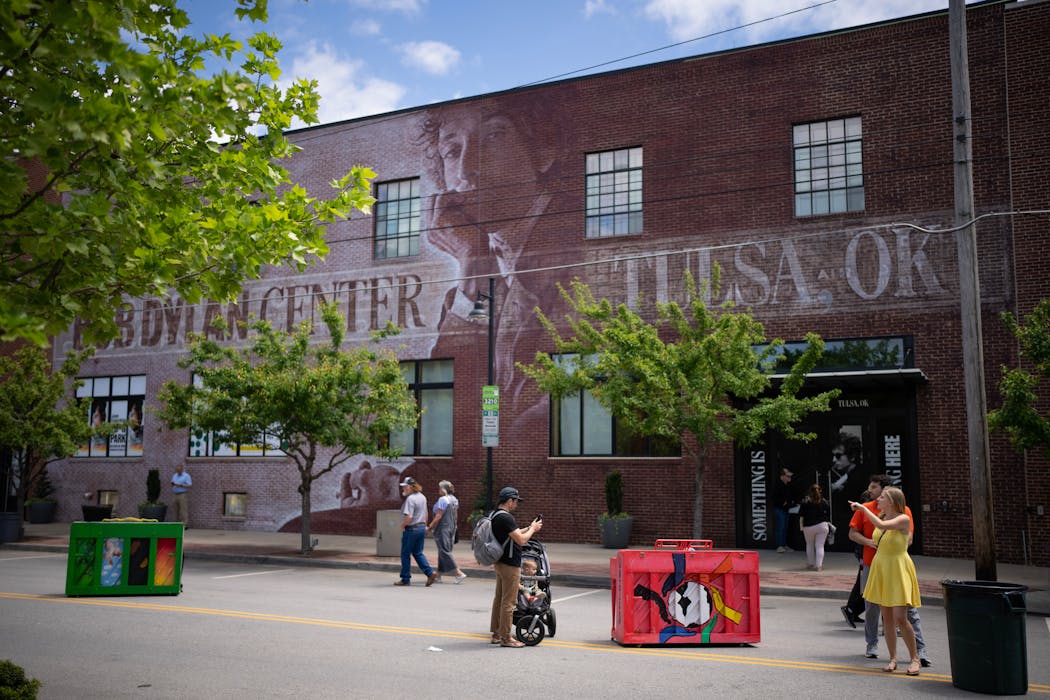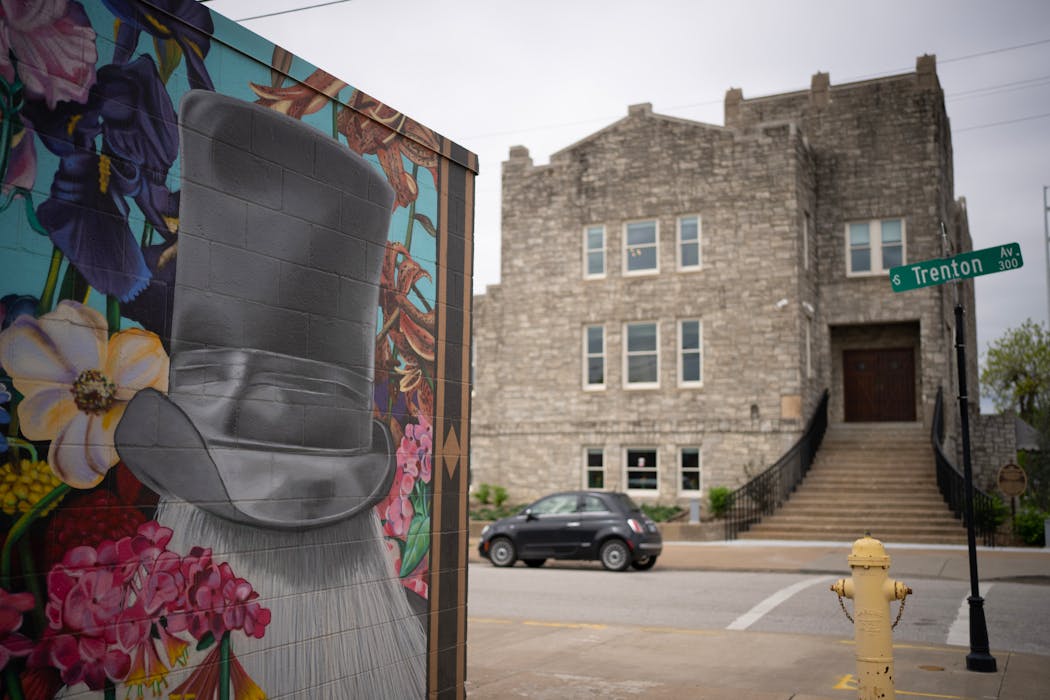Why fans of Bob Dylan, Leon Russell and Woody Guthrie are flocking to Tulsa
Oversized photos of old-timers like Ernest Tubb and Kay Starr ring the dance floor. That's not surprising, since Cain's Ballroom has been around for 99 years.
Nowadays, newer names like Big Thief and Lainey Wilson take to the bandstand. But the landmark music hall still proudly boasts that it's "the home of Bob Wills."
"Take me back to Tulsa," Wills implored in a song of that name, in which the King of Western Swing was getting cold feet about marrying a Louisiana woman. Take a tip from Wills and beat a hot trail to Tulsa, regardless of your romantic situation.
The Oklahoma oil town in the middle of America has suddenly achieved a critical mass for music lovers. With the opening last year of the must-see Bob Dylan Center, and the remarkably eccentric Church Studio, Leon Russell's renovated recording complex, Tulsa has "y'all come" writ large. A night of live music at Cain's shouldn't be missed, as well as a visit to the Woody Guthrie Center.
Bob Dylan and Woody Guthrie
The Guthrie Center is the reason the Dylan museum is in Tulsa. The Minnesota icon was impressed by what the George Kaiser Family Foundation did for folk-music giant Guthrie, one of Dylan's heroes, so he sold his lifetime of keepsakes to the foundation, which then created the Bob Dylan Center.
Located in an old warehouse two doors down from the Dylan depository, the Guthrie Center transports you back to the Oklahoma Dust Bowl (be sure to don the virtual-reality goggles). Recordings and handwritten lyrics showcase the diversity of songs (kids' tunes, commentaries about poverty and labor, etc.) by the Oklahoma-born writer of "This Land Is Your Land."
When our tour guide pointed out Guthrie's damning lyrics about notorious New York landlord Fred Trump, father of you-know-who, one visitor loudly proclaimed her objection and stormed out of the museum.
There are likely to be no such controversies at the $10 million Bob Dylan Center. Its 29,000 square feet are packed with Bobabilia: performance footage and interviews, posters and paintings, articles and essays, bootleg LPs and outtakes. There's even an iron gate sculpture by the bard — just no Grammys or trophies of any kind.
What a saver Bob has been: artifacts like the leather jacket he wore when he went electric at the 1965 Newport Folk Festival. Priceless ephemera like a 1964 letter of admiration from Johnny Cash and a postcard of apology from Pete Seeger. Not displayed during the self-guided tours are the extensive archives of manuscripts and papers, available by appointment for historians, scholars and journalists.
The Church and Cain's
The Church Studio received a multimillion-dollar makeover and reopened in early 2022, thanks to educator-turned-preservationist Teresa Knox. She kept many of the late musician Russell's idiosyncratic things (his private olive-green bidet in the belfry, a hand-carved chair with ivory filigree, etc.) in a 1915 Methodist Episcopal church he converted into a studio in 1972. The Church Studio was the home of the Tulsa Sound, where Eric Clapton, J.J. Cale, Bonnie Raitt, Tom Petty, Phoebe Snow, Russell and others recorded.
During the renovation, Knox collected choice equipment such as a Neve recording console from New Orleans producer Daniel Lanois and microphones David Bowie used to record in Berlin in the late '70s.
The Church is available for recording sessions — and tours, where you can see Russell's trademark top hat, childhood art and other memorabilia. Knox also books special solo concerts in the large studio by the likes of Kenny Loggins and Taj Mahal.
Cain's, built in 1924 as a garage for the wealthy founder of Tulsa, is a classic dancehall. Bob Wills & the Texas Playboys broadcast their radio show from the ballroom in the 1930s.
Cain's was one of only seven venues where the Sex Pistols, the notorious British punk band, performed on their 1978 U.S. tour. Volatile bassist Sid Vicious famously punched a hole in the wall of the Green Room. The hole-in-the-wall section has been preserved and is on display at Cain's along with enlarged photos of other headliners including Hank Thompson and Kitty Wells.
With a capacity of 1,800 (there are seats in the mezzanine), Cain's is still the must-play music room in Tulsa.
Beside Wills, Russell and Cale, Oklahoma's second largest city has been home to such music stars as Roy Clark, drummer Jim Keltner, David Gates of Bread, the Gap Band, guitarist Jesse Ed Davis, Dwight Twilley, JD McPherson and Wayman Tisdale, the basketball hero-cum-jazz-bassist.
Other attractions
The historically essential Black Wall Street tells the story of the 1921 race massacre. Murals, a museum and a culture center commemorate this tragic event in the Greenwood district.
The unusual architecture of Oral Roberts University has curious appeal, along with the campus' gigantic sculpture of Praying Hands (an Instagram spot, for sure).
The Golden Driller, another Insta site, is the third-tallest statue of a single person in North America. The 75-foot-tall, 22-ton oil worker was erected in 1966 for the International Petroleum Exposition. The oil man has a shoe size of 393DDD. No wonder the Golden Driller was named one of the 10 quirkiest destinations in the nation in 2006.
The Center of the Universe is an acoustic curiosity. Located in the heart of downtown Tulsa, it's a vehicle-free space where sound resonates in a mysterious way.
Housed in the former estate of an oil pioneer, the Philbrook Museum of Art features a striking collection of Native American art as well as massive formal gardens, a perfect place for solitude or a wedding. The Gilcrease Museum, established by an Indigenous oil magnate, boasts the world's largest collection of art of the American West.
Memorial Park Cemetery has the conspicuous headstones of music heroes Clark and Russell as well as the plain graves of Wills and comic Sam Kinison, for which you might need directions from a cemetery worker.
Good eating
In a week's time, we had nothing but good meals in Tulsa. Recommended are Bramble (breakfast), Amelia's (gourmet American), Smoke (barbecue), French Hen (French), Sisserou's (Caribbean), the Tavern (American, late-night menu) and Bull in the Alley (high-end steakhouse and piano bar), with its mysterious speakeasy-type alley entrance.



